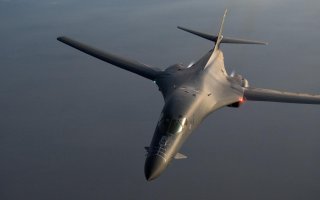Integrated Battle Station: A Massive Upgrade for America's B-1B Bomber Fleet
An exciting leap forward in the modernization of the famous bombers.
Here's What You Need to Know: The upgrades come even as the U.S. Air Force has suggested it could retire the B-1B Lancer beginning in 2025.
An eight-year-long project to install the Integrated Battle Station (IBS) on the B-1B Lancer fleet has been completed ahead of schedule, the United States Air Force announced. A total of sixty of the late Cold War-era aircraft went through the modification process, which began in late 2012. It was reported to be the largest and most complicated modification performed to date on the B-1 and it gave the flight deck a completely new look.
The battle station was developed as three separate modifications that included a Fully Integrated Data Link, Vertical Situational Display Unit and Central Integrated Test System.
“During development, it became obvious that modifying the same aircraft three times would be detrimental to aircraft availability and would create numerous aircraft configurations,” said William Barnes, B-1B Systems program manager at the Air Force Life Cycle Management Center. “Thus Integrated Battle Station was born.”
The modification took thousands of man hours and involved 120 maintainers assigned to the modification line working in two shift schedules. The program began with the installation of the Center Integrated Test System (CITS), the display in the cockpit that replaced the outdated computer monitors that were used to help troubleshoot issues with the jet’s systems. This was followed by the Link 16-supporting Fully Integrated Data Link (FIDL) and then the Vertical Situational Display Unit (VSDU).
Boeing has been the prime IBS contractor since it bought Rockwell International’s aircraft business. Defense Daily reported that the first two B-1Bs with Boeing-installed IBS were test planes delivered in 2012, while the first of the remaining sixty B-1Bs were delivered to Dyess Air Force Base (AFB), Texas in January 2014 with IBS installed by Tinker AFB, Okla., technicians.
Under the original requirements of the program it was estimated it would take about 218 days to complete each bomber, but Tinker was able to set an internal goal of about 170 days and the fastest turnaround for a single aircraft was just 154 days. The onset of the novel coronavirus pandemic earlier this year had little effect on the timeline of the modification.
“For the IBS workforce, Covid restrictions were very limited,” said Rodney Shepard, director of the 567th Aircraft Maintenance Squadron. “At the time of the outbreak, the IBS modification line only had one aircraft in-dock at the Maintenance Repair Overhaul Technology Center, with three aircraft already transitioned to post-dock flight operations.”
The Air Force has said that the completed modification will enhance B-1B flight operations and give the crews more flexibility in performing their various missions.
The program was able to be accomplished quickly due to the commonality, which included designing and installing hardware—including displays—that worked for all three modifications and by executing the software upgrades for all three components as one single package. The IBS development phase, which included flight testing and modifications of the two test aircraft, cost $380 million; while the IBS production phase of the upgrade cost $894 million bringing the total cost to $1.27 billion.
These upgrades have come even as the U.S. Air Force has suggested it would retire the B-1B Lancer beginning in 2025 as the B-21 Raider comes into service. The last B-1B could leave service around 2036. Critics of that move have argued that the strategic bombers have more than proven their worth in recent years and the Lancer remains a fundamental part of the U.S. Air Force’s combat airpower.
Earlier this year two B-1B Lancers took part in a twenty-four-hour drill flying from Andersen Air Force Base, Guam to conduct training in Alaska and Japan. The exercise highlighted the bombers’ ability to hold any target at risk worldwide. For now, the B-1B remains the “backbone” of the U.S. Air Force’s bomber fleet. The aircraft, which can top 900mph, has the largest payload for a bomber and can carry up to 75,000 pounds of guided and unguided weapons.
Peter Suciu is a Michigan-based writer who has contributed to more than four dozen magazines, newspapers and websites. He is the author of several books on military headgear including A Gallery of Military Headdress, which is available on Amazon.com.
This article first appeared earlier this year.
Image: Flickr / U.S. Air Force photo / Master Sgt. Ben Bloker

